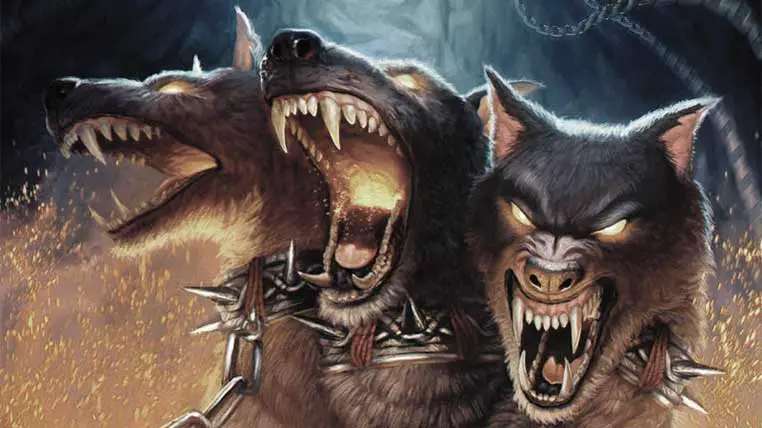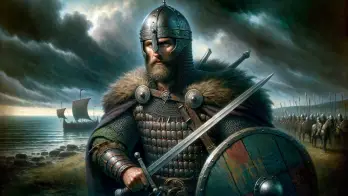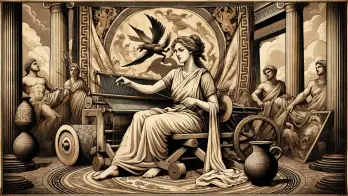In Greek mythology, Cerberus is the offspring of two primordial monsters: the giant Typhon (who, according to the poets Hesiod and Apollodorus of Athens, was the son of the goddess of the earth, Gaia, and the dark Underworld Tartarus) and Echidna, a legendary creature, half viper, half woman.
Besides the three-headed dog, Typhon and Echidna also had several other fearsome offspring, such as the Lernaean Hydra (killed by Hercules), Orthrus (another dog with two heads), and Chimera.
As a servant of Hades (the Greek god of death in Greek mythology), Cerberus was the tireless guardian of the Underworld and prevented souls from the underground kingdom from returning to the world of the living.
Etymology
The etymology of the name “Cerberus” is uncertain. Some ancient sources believed that the name of the guardian of the Underworld was derived from the Greek word “kreōboros,” which means “flesh-devouring.”
However, present-day linguists disagree with this meaning and propose numerous other theories.
Some have tried to trace the origin of the name to the Sanskrit term “sarvarā” (which translates as “spotted”), the epithet of one of Yama’s (the god of death) dogs.
Bruce Lincoln, a professor of religion at the University of Chicago, has suggested a connection to Garmr, one of Hel’s (the goddess of the Underworld in Norse mythology) watchdogs.
According to Lincoln, both names could be derived from the Proto-Indo-European root “-ger,” which means “to growl.”
However, such theories have been met with skepticism. Whatever the origins of the name Cerberus, it likely predates Greek civilization.
Homer calls the beast “kyōn” (which translates as “hound”), and in other ancient texts, he is simply called “Hades’ dog.”
What does Cerberus, the guardian of Hades' Underworld, look like?
Ancient sources have sometimes offered contradictory descriptions of Cerberus’s appearance.
According to Hesiod (8th or 7th century BCE), the first author to describe the underworld guardian, the beast had fifty heads. On the other hand, Pindar (5th century BCE) portrayed Cerberus as a creature with one hundred heads.
However, nearly all subsequent sources limited him to only three heads, with venomous snakes in his mane and along his spine and a snake for a tail.
A notable exception was the Roman poet Horace (65-8 BC), who described the monster as having one head covered with one hundred snakes and three long, forked tongues with which he whipped the air.
John Tzetzes, an 11th-century Byzantine poet and scholar, sought to reconcile all these conflicting versions by giving Cerberus a new appearance – fifty heads, with only three dog heads, and the rest being different other beasts.
Genealogy
Parents
- Typhon
- Echidna
Siblings
- Orthrus
- Hydra
- Chimera
Cerberus had two monstrous parents – Typhon and Echidna, two mythological creatures born shortly after the creation of the cosmos.
In addition to Cerberus, Typhon and Echidna were the parents of three other bloody monsters, which appear in numerous Greek myths and legends:
- Orthrus – the two-headed watchdog of the giant Geryon, eventually killed by Hercules;
- Hydra – a many-headed serpent, also slain by Hercules;
- Chimera – a hybrid creature that combined features of a lion, goat, and serpent, killed by the hero Bellerophon.
Myths and legends
The three-headed dog is one of the most important creatures in Greek mythology, and there are several fascinating myths about the guardian of the Underworld.
The last labor of Hercules
The three-headed monster is best known for his connection to the myth of Hercules, one of the most beloved heroes of Greek mythology.
The legendary hero, son of Zeus and the mortal Alcmene, was forced to complete twelve arduous labors for his cousin, Eurystheus, the king of Mycenae.
According to one version of the myth, capturing the dog Cerberus was the final task, supposed to be impossible, but the hero succeeded in completing it.
However, Hercules received help to finish his last labor.
First, the hero had to be initiated into the mysteries of the cult of Demeter and Persephone, an ancient religious sect that promised its followers a privileged afterlife. Hercules’ initiation into this cult’s secrets helped him pass unscathed into the Underworld.
In other myths, Heracles was aided either by Hermes (the messenger of the gods and guide to the Underworld of Hades), by the goddess Athena, or by both.
In the Underworld, Heracles faced several of Hades’ acolytes, including Menoetius (or Monoetes). He also met three legendary heroes, captive in Hades’ realm – Ascalaphus (who had angered Demeter), Theseus, and Pirithous (who had tried to abduct Persephone).
According to Greek myths and legends, Hercules could free Ascalaphus and Theseus, but not Pirithous.
Now, capturing the best Cerberus was a challenging endeavor.
Thus, Heracles presented himself before Hades, asking to “borrow” his faithful guardian. Fearing the hero’s power, the lord of the Underworld agreed on one condition: Heracles had to subdue Cerberus without using any weapons.
The hero agreed.
He grabbed the beast firmly by his three thick necks and squeezed him like a vice. His snakes hissed and tried to bite him. His tail thrashed and writhed like a dragon’s. The three-headed dog struggled but was no match for Hercules‘ strength.
However, many ancient artistic representations depict the hero fighting the three-headed monster using a bat or a massive stone.
In the Roman tragedy “Hercules Mad” by Seneca (1st century BC), it is said that the hero used his bat to subdue Cerberus.
There is also an early version of the myth in which Heracles fought the god of the Underworld himself for Cerberus.
Hades broke his promise in another legend and refused to let Heracles take Cerberus out of the Underworld. As a result, the hero shot the god with an arrow dipped in the venom of the Hydra.
There is also a variant in which Persephone, the queen of Hades, is the one who captures the beast and delivers it to the hero Heracles.
Orpheus
Heracles was not the only mortal who traveled through Hades’ realm and returned alive and unscathed. Orpheus achieved a similar feat.
After losing his wife, Euridice, on their wedding day, Orpheus swore to retrieve her from the clutches of death.
Unlike Orpheus, Orpheus entered the Underworld not aided by physical strength but by his unmatched musical skill.
According to legends, the talented musician played his enchanted lyre so beautifully that all the monstrous creatures in the Underworld were enchanted by his music and let him pass safely through the land of the dead.
The Roman poet Virgil wrote that upon hearing Orpheus’s music, “Cerberus stood gaping and forgot to bark.”
Symbolism
The symbolism of the three-headed dog, which appears in numerous ancient works of art, also appears in Norse mythology. Here, the monster is known as Garmr and, like Cerberus in Greek mythology, has the role of guarding the realm of the dead.
In contrast, Celtic mythology speaks of a fierce dog that accompanies processions dedicated to the spirits of the dead on Samhain (Halloween) night.
In British myths and legends, the black dog is often mentioned as a spectral animal that haunts the regions of Wales and Scotland. Those who encounter this “black dog” will have bad luck and unfortunate events.
The peculiarity related to the dark appearance of the beast had its origins in the Middle Ages (476-800) when the church had decided that some animals (such as black cats, black dogs, black wolves, toads, rats, or owls) are somehow linked to the demonic forces of hell.
These animals have been associated with witchcraft and the worship of the Devil.
In modern times, Cerberus, as a diabolical creature, is often “borrowed” by scriptwriters who do not hesitate to give it an important role, especially in horror films.
Some representative examples are given by “Cujo,” the dog from the novel of the same name by the well-known author Stephen King, and “Devil Dog,” the infernal dog presented in the 1978 film directed by Curtis Harrington.
Questions and answers about Cerberus
Who was Cerberus in Greek mythology?
Cerberus was a creature in Greek mythology, known as a three-headed dog that guarded the entrance to the Underworld. He was feared and respected by all who knew of him, as he was a powerful and relentless guardian of the realm of the dead.
What was Cerberus’ role in Greek mythology?
Cerberus was the guardian of the Underworld, and his role was to prevent the living from entering and the dead from escaping. He was a fierce and unrelenting creature who would stop at nothing to protect the realm of the dead.
What did Cerberus look like?
Cerberus was a monstrous creature with three heads, each with a set of sharp teeth. He had a snake for a tail and a coat of snakes and dragon heads. He was a fearsome and imposing sight, and his appearance alone was often enough to deter those trying to enter the Underworld.
How did Hercules defeat Cerberus?
Hercules was tasked with capturing Cerberus and bringing him to the surface world in one of his twelve labors.
The Greek hero defeated Cerberus by using his tremendous strength to subdue the dog and then carrying him out of the Underworld.
Cerberus was then brought to the surface world and presented to King Eurystheus as part of Hercules’ labors.
What was the purpose of the three heads of Cerberus?
The three heads of Cerberus allowed him to see in all directions and guard the entrance to the Underworld more effectively. With three heads, Cerberus could detect potential intruders and react accordingly, making him an even more formidable guardian.
What was the origin of Cerberus?
Cerberus was the offspring of the monstrous Echidna and the giant Typhon, making him a sibling of other famous monsters like the Chimera and the Hydra.
He was born into a family of powerful and fearsome creatures, and his origins help to explain his own formidable nature.
What happened to Cerberus after Hercules returned him to Hades?
After being returned to Hades, the beast continued serving as the Underworld’s guardian. He was revered by the ancient Greeks as a powerful and fearsome creature, and his reputation as the guardian of the realm of the dead only grew over time.
How has Cerberus been depicted in popular culture?
The guardian of the Underworld has been depicted in numerous works of literature, film, and art, often as a fearsome and imposing creature that guards the entrance to Tartarus.
He has been portrayed in various ways, from a faithful companion to Hades to a monstrous beast feared and respected by all who come into contact with him.
His image has become an iconic symbol of the Underworld and is recognized around the world as a symbol of death and the afterlife.
At Ancient Theory we only use trusted sources to document our articles. Such relevant sources include authentic documents, newspaper and magazine articles, established authors, or reputable websites.
- Maurice Bloomfield - Cerberus, the Dog of Hades: The History of an Idea. Open Court Publishing Company, 1905.
- R. L. Fowler - Early Greek Mythography: Text and Introduction. Oxford University Press, 2000.
- Karl Schefold - Myth and Legend in Early Greek Art. Thames and Hudson, Londra, 1966.
- Cerberus. britannica.com. [Source]
- Cerberus In Greek Mythology. greeklegendsandmyths.com.
- Amanda Knapp - Cerberus in Greek Mythology. The Three-Headed Dog. [Source]






